So much history-making postwar art missing, so little time!
The Pebble Beach Art Heist had gone cold for a while, but now, thanks to a new website ["made on a Mac"!] it is flaming back to life. And for the first time, we get to see a photo of what is surely one of the Most Important Missing Paintings In The World: the Pebble Beach Pollock.
Recall that in 2009, Angelo Amadio [aka Benjamin Amadio] and Dr. Ralph Kennaugh, a couple [just friends!] of art collectors relocated from Boston to Pebble Beach so the [much[ younger Mr. Amadio could finish/start law school. Soon after the move, they discovered that practically their entire art collection, valued at between $20 and 80 million, had been stolen from the foreclosure house they'd just rented. The collection, assembled for the couple by the art investor and/or gallery owner Amadio, included paintings by Matisse, Renoir, Rembrandt, and Miro, and a major, early Jackson Pollock.
Also stolen: all the documentation of the art collection. Also, the Pollock had never been published or exhibited. Also, in news reports, Amadio would inconsistently refer to things as paintings when they were prints, or drawings when they were etchings.
Which is why the website. With their lawsuit against the Monterey County sheriff's office dismissed and a cloud of uncertainty and suspicion hanging over the caper, Amadio and Kennaugh have published a website, pebblebeachartheist.com, to prove the art exists. And to recover it, of course, because it's still missing.
There's finally a list of all the stolen works, with photos ["ACTUAL PHOTOGRAPHS"] and dozens of snapshots from more carefree days in the couple's previous homes, when the art was still on the walls. It's like found Louise Lawler.

How much is that Dali on the table? "Monterey Friend of ABA Visits Boston, MA Clarendon St. Cira 2008"
Which, fine, but let's just get it out of the way: everything but the Pollock is fluff. The Matisses--still lacking detailed documentation--are late prints. The Miros? Late doctor's office lithographs. The Renoir and Van Gogh drawings? Sketchy scraps. The G.H. Rothe mezzotints of muscular dancers and stampeding stallions? Mall art. The Rembrandts are random, pocket-sized etchings.

Other of Kennaugh's friends appearing in "Rembrandts' Right," Columbus, OH, 1990s
In Columbus where he first met the undergraduate Amadio, Dr. Kennaugh hung the Rembrandts in the dining room. In Boston, one, A Woman Beneath A Tree [AKA: Woman Making Water], which depictsa peasant woman squatting to take a piss, where Rembrandt intended it to go: in the Spare Powder Room.
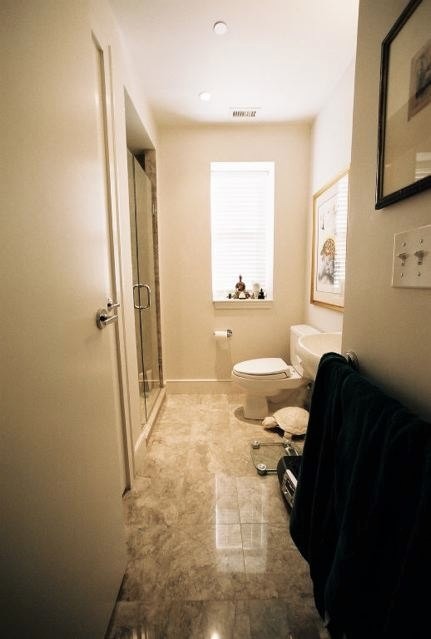
Then there's this cryptic photo of a grey-templed, shirtless, once-fat man in Amadio's college condo in Columbus:
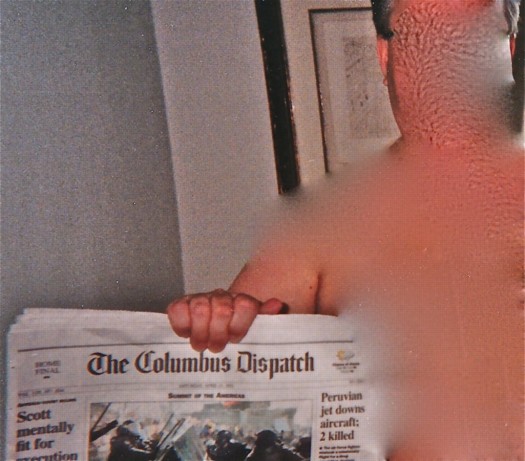
"Matisse Etching, AA's Undergraduate Condo, Witness Diet B4 Picture"
Judging by the Peruvian shooting headline, he began his diet in late April 2001. At the bottom of the gallery page, it states, "Some Images Modified To Protect Identity Of A Material Witness."
Perhaps he is the guy Amadio originally fingered in the heist, the friend who helped transport the artworks in the special truck, as depicted here in the gallery's "Art On The Move" series:

"Art On The Move: Secure Climate Controlled Truck with Video, GPS, and Other Security"
Alright alright, you say, let's see the Pollock! Surprisingly enough, the Pollock, a large [46x70"], signed [!], oil-on-canvas drip painting from 1944 that would account for the entire $60, $20, or $80 million Amadio has claimed for the heist, does not appear even once in the couple's house photos. But they do have a picture, finally!
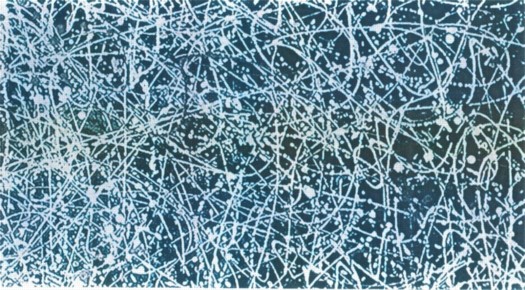
1944
46" x 70"
Untitled Mix Oil Unprimed On Unprimed Canvas
Signed Jackson Pollock Bottom Right
The Itemized Checklist also includes this text:
Provenance includes letters of transfer from all prior owners, photograph with Jackson Pollock, independent expert and scientific authentication, insurance appraisals and authentication and offers for rider. Other details, provenance, and identifying markers have been excluded from this description to guarantee and protect authenticity upon recovery.And there you go! So 1944. That means the Pebble Beach Pollock was painted around the same time and using the same materials as the slightly larger, horizontally oriented, Gothic, which is at MoMA:
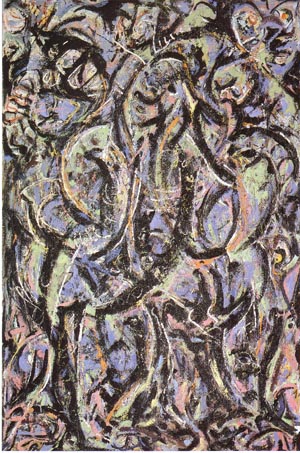
Gothic, 1944. Oil on canvas, 7' 5/8" x 56" via moma
So at least 10 months before he moved to Springs, and got a barn, and fully developed his signature technique of making drip paintings on the floor, using enamel housepaint to make sinuous skeins of paint, because oil was too viscous, Pollock actually managed to create a full-blown drip painting? That is incredible!
And yet for some inexplicable reason, in 1945, Pollock could not shed his jagged, thickly textured, gestural style, and he ends up making a painting like this one, which Amadio must know very well, seeing as how it's at the MFA Boston, and he's got a nearly identically sized Pollock from around the same time:
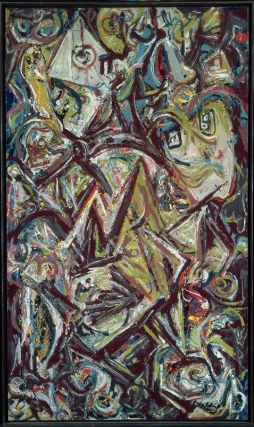
Troubled Queen, 1945
74 1/8 x 43 1/2 in.
Oil & alkyd on canvas
via mfa boston
I think we're barely coming to terms with the far-reaching implications and importance of the Pebble Beach Pollock which, now that this photo has been released, stands ready to rewrite art history and auction records alike. Should it ever be recovered, and its "independent expert and scientific authentication" and offers for insurance riders and whatever straightened out, that is. Here's hoping that the Kennaugh-Amadio's website works its magic and lures this major masterpiece back into the light. Please RT!
pebblebeachartheist.com [via professor toro at the monterey herald]












